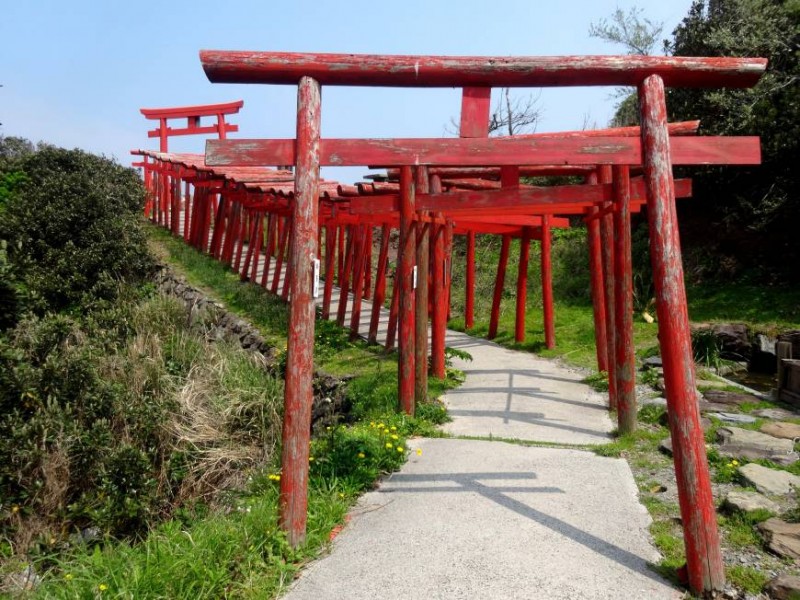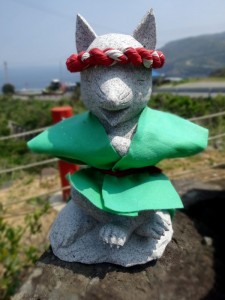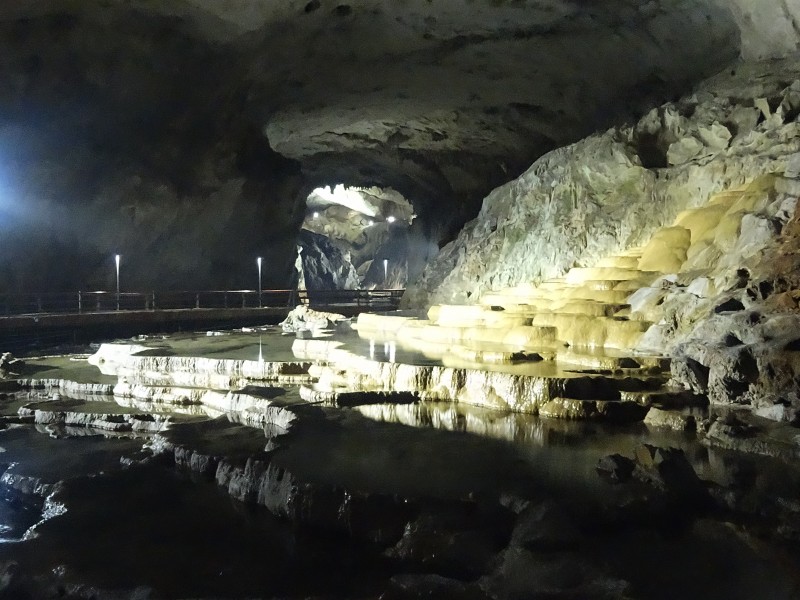
Entrance way to Motonosumi Inari Shrine in Yamaguchi (photo by Mandy Bartok)
Above and below the Yamaguchi plains
by Mandy Bartok
The Japan Times Jun 13, 2015
Three meters above my head, the rectangular offering box of Motonosumi Inari Shrine seems impossibly out of my reach. For the 23rd time, I wind back my arm and attempt to lob my chosen donation between the narrow slats. For the 23rd time, the coin takes on a trajectory I’m certain I didn’t intend … and soars over the torii gate where the box balances and into the road.
“There’s probably a time limit to the luck, you know,” my husband mumbles from somewhere behind me. He, of course, launched his lucky coin into the offering box on the third or fourth try.

A cutified fox statue at the Motonosumi Inari Shrine (courtesy Bartok)
Despite his calm countenance, I can almost hear the tapping of his toes. My daughter, perched on a rock next to him, gives me a glassy-eyed stare of boredom. Even the stone fox statue beside her, an homage to the animal that allegedly convinced a local fisherman to construct this shrine back in 1956, bears a look that feels slightly condemning. Silently, I once again fling both flimsy coin and a string of unkind words at the offering box. This time, the money lands on top of the torii’s main support beam, a slight improvement in my opinion but not close enough.
Until early 2015, Motonosumi Shrine’s main claim to fame was this offering box, one of the most unusually placed of any shrine in the country. Then a CNN Travel article in late March listed this out-of-the-way location in the Nagato region of northern Yamaguchi Prefecture as one of the most beautiful sights in Japan, showcasing photos of its snake-like torii gate tunnel. The once sleepy byways that lead to the seaside shrine have certainly seen an uptick in traffic (though not yet an increase in useful directional signs), but on this late spring morning, the crowds are light enough to allow me innumerable attempts at my donation.
Around the 45th try, I finally hear the coin rattle into the depths of the offering box and pump my fist in victory. Only the unblinking gaze of the stone fox witnesses my accomplishment. My family has apparently long given up hope, already halfway along the twisting path of torii gates.
For a shrine that is only in its 6oth year, the 123 torii that lead to the ocean are clearly showing signs of severe weathering. A stack of new gates, with a fresh coat of vermilion coloring, sits halfway down the 100-meter-long path, primed to be inserted in the tunnel’s numerous gaps. The initial gates were placed here over the course of a decade. However, with the recent media attention, it seems the upgrades will be finished in much less time.
At the end of the torii tunnel, we pick our way carefully across the rocks to view the water. Pockets of what appear to be pink krill swirl around in the slightly rough seas, their lingering path pierced only by the occasional fisherman’s trawler. In a small cove, a diver makes repeated trips down to the ocean floor. We’re a fair distance away but judging from her long-handled knife and the size of the objects she continuously tosses in her floating basket, I’m willing to bet that she’s harvesting sea urchin. Northern Yamaguchi is known for the creamy delicacy and my stomach gives me a pointed reminder that lunch should be the next stop on the itinerary.
To our dismay, meal options are few and far between on the hour-long drive from Nagato’s coast to the Mine region in Yamaguchi’s interior. We eventually settle for a quick lunch at one of the massive gift shops lining the approach to Akiyoshi Cave. The room is packed with tour groups and harried servers but our kawara soba, a local specialty consisting of green-tea flavored noodles topped with shredded beef, egg and green onions served on a hot roof tile, cures our food cravings.
If Yamaguchi’s scenery is captivating above the crust of the Earth, it’s equally impressive below it. A narrow cut in the mountainous landscape, reached by a short covered bridge, is the unassuming entrance to what experts credit as the largest limestone cavern in East Asia. While the entire cave system stretches at least 10 km, only a short section of it is open to the public.
We pause just inside the gaping entrance to let our eyes adjust to the dim light. To our left, a handful of sure-footed visitors opts for the “high road,” a trail that runs near the roof of the cavern. With chains and iron studs embedded in the rock, it’s not the route for a family with a preschooler. Instead, we stick to the main path along the subterranean river, spotlights glinting off the glassy surface.
While Akiyoshi Cave boasts the typical stalactites and stalagmites of other subterranean chambers, the pattern of erosion here has created some highly irregular formations. Water gathers in massive indentations in the Hyakumaizara (Hundred Dinner Plates), a set of saucer-like pools. A large open area of terraced puddles resembles the above-ground hillside rice paddies for which it is named. Near the cave’s far entrance, the 15-meter-tall koganebashira (gold pillar), formed over the course of a millennia, towers over us mere mortals below.


Leave a Reply